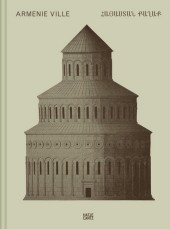 Neuerscheinungen 2016Stand: 2020-02-01 |
Schnellsuche
ISBN/Stichwort/Autor
|
Herderstraße 10
10625 Berlin
Tel.: 030 315 714 16
Fax 030 315 714 14
info@buchspektrum.de |

Martina Corgnati, Giacomo Daniele Fragapane, Gobbi. Claudio, Sophie Jung
(Beteiligte)
Claudio Gobbi
Arménie Ville A visual essay on Armenian architecture
Text: Corgnati, Martina; Daniele Fragapane, Giacomo; Jung, Sophie u. a.
2016. 160 S. 125 Abb. 217 mm
Verlag/Jahr: HATJE CANTZ VERLAG 2016
ISBN: 3-7757-4115-1 (3775741151)
Neue ISBN: 978-3-7757-4115-6 (9783775741156)
Preis und Lieferzeit: Bitte klicken
Typologie sakraler Baukunst: eine Fotostudie über armenische Kirchenbauten in über 25 Ländern
Seit 2007 arbeitet Claudio Gobbi (geb. 1971 in Ancona) an der systematischen Erfassung armenischer Kirchenbauten vom Mittelalter bis in unsere Tage. Die Serie mit dem Titel Armenie Ville umfasst neben eigenen Aufnahmen des Fotokünstlers auch gefundene Bilder aus Archiven, dem Internet oder Auftragsarbeiten anderer Künstler. In den Fotografien aus über 25 Ländern von Westeuropa bis zum Kaukasus spürt der in Berlin lebende italienische Fotograf den Besonderheiten armenischer sakraler Baukunst und der bestechenden Einfachheit ihrer Formen nach, die seit über 1500 Jahren unverändert geblieben sind. Hierin setzt Claudio Gobbi seine konsequente Suche nach Schlüsselbildern verschiedener Kulturräume fort und umkreist dabei die Themen Zeit, Erinnerung, Migration und das kulturelle Erbe eines Volkes sowie Konzepte von Urheberschaft, Serialität und Repräsentation.
Claudio Gobbi ( 1971 in Ancona) has been working since 2007 on the systematic recording of Armenian religious architecture from the Middle Ages to the present. Besides the photographers own photographs, the series, with the title Arménie Ville, also comprises found images from archives, pictures from the Internet and from commissioned artists. Spanning more than twenty-five countries from Western Europe to the Caucasus, the Berlin-based Italian artist traces the specific features of sacral Armenian architecture and the captivating simplicity of its forms, which have remained unchanged for more than 1500 years. Investigating the concepts of authorship, serialization, and representation, Claudio Gobbi carries on his quest for key images of various cultures and in the process addresses the subjects of time, memory, migration, and the cultural legacy of a people.
Seit 2007 arbeitet Claudio Gobbi ( 1971 in Ancona) an der systematischen Erfassung armenischer Kirchenbauten vom Mittelalter bis in unsere Tage. Die Serie mit dem Titel Arménie Ville umfasst neben eigenen Aufnahmen des Fotokünstlers auch gefundene Bilder aus Archiven, dem Internet oder Auftragsarbeiten anderer Künstler. In den Fotografien aus über 25 Ländern von Westeuropa bis zum Kaukasus spürt der in Berlin lebende italienische Fotograf den Besonderheiten armenischer sakraler Baukunst und der bestechenden Einfachheit ihrer Formen nach, die seit über 1500 Jahren unverändert geblieben sind. Hierin setzt Claudio Gobbi seine konsequente Suche nach Schlüsselbildern verschiedener Kulturräume fort und umkreist dabei die Themen Zeit, Erinnerung, Migration und das kulturelle Erbe eines Volkes sowie Konzepte von Urheberschaft, Serialität und Repräsentation.
Claudio Gobbi ( 1971 in Ancona) has been working since 2007 on the systematic recording of Armenian religious architecture from the Middle Ages to the present. Besides the photographer´s own photographs, the series, with the title Arménie Ville, also comprises found images from archives, pictures from the Internet and from commissioned artists. Spanning more than twenty-five countries from Western Europe to the Caucasus, the Berlin-based Italian artist traces the specific features of sacral Armenian architecture and the captivating simplicity of its forms, which have remained unchanged for more than 1500 years. Investigating the concepts of authorship, serialization, and representation, Claudio Gobbi carries on his quest for key images of various cultures and in the process addresses the subjects of time, memory, migration, and the cultural legacy of a people.


